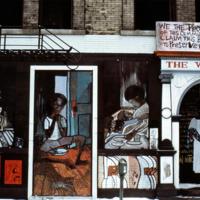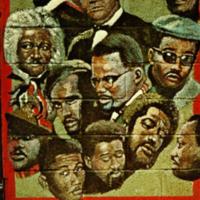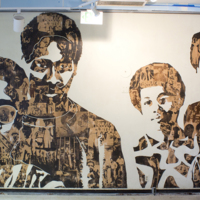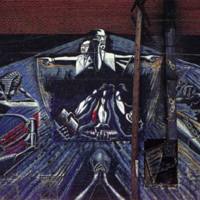![John Weber, All Power to the People, Cabrini-Green Public Housing Development, 357 W. Locust St, Chicago, 1969 [destroyed].jpg John Weber, All Power to the People, Cabrini-Green Public Housing Development, 357 W. Locust St, Chicago, 1969 [destroyed].jpg](https://486312.frmmmguz.asia/files/square_thumbnails/5bee9c55de2e128c0239ac4a0793b9c0.jpg)
All Power to the People
In 1969, in the courtyard of Saint Dominic’s Church in Cabrini-Green, John Pitman Weber painted All Power to the People with a team of black teenagers. The 37-foot-long mural put the antislavery leader Frederick Douglass alongside Malcolm X, Huey P. Newton and Erika Huggins on the right-hand-side. On the left are skeletons of police officers and a statement by the leader of the Chicago Black Panther Party, Fred Hampton: "Dare to Struggle, Dare to Win." A raised Black Power fist, enveloped by flames, holds broken chains in a symbol of self-emancipation. A few months after the creation of this mural, Fred Hampton was shot and killed by the FBI under J. Edgar Hoover’s COINTELPRO. Weber was a white Harvard graduate and Fulbright scholar. The mural was one of the first collaborations between untrained community residents and a trained artist, a method that became common practise for American community murals.

Wall of Truth
Although sharing an address with the famous Wall of Respect, the Wall of Truth was different. Whilst the Wall of Respect exalted black role models, leaders and liberators, the Wall of Truth wove negative scenes of poverty, brutality and racism into the fabric of the urban environment. Rather than promoting racial pride, it highlighted racial disparities. “The intent on the opposite side [of the road] was that things had gone more militant,” muralist Eugene Wade explained: “more blackness was needed in terms of representing the Black Power symbol and the whole thrust of what was happening in the black community.” Wade notes that “people were getting angry and fed up, so what we were trying to do was implement the attitude and the mood."The Wall of Truth was a significantly larger mural than its Chicago neighbour, the Wall of Respect. It spanned the length of an apartment building, and wrapped around onto an adjoining wall. It contained nine separate narrative panels and was one of the first instances that a radical black past was visualised in the streets through the antislavery leaders Frederick Douglass and Nathaniel Turner, as well as Mary McLeod Bethune, W.E.B. Du Bois, H. Rap Brown, Stokely Carmichael, Marcus Garvey, Huey P. Newton, Fred Hampton, and Malcolm X.

Nation of Islam
In 1990, this mural titled Nation of Islam at Charles Place in Brooklyn was created. The mural unites many radical figures of black history, including the antislavery leader Frederick Douglass, W.E.B. Du Bois, Elijah Muhammad, H. Rap Brown, Malcolm X, Marcus Garvey, Eldridge Cleaver and Bobby Seale. It has now been destroyed.

The Black Experience
In 1970, a group of seven black UCLA art students created a mural titled The Black Experience on the first floor of the Ackerman Student Union building. The mural, which measures 10 feet by 27 feet, was obscured for 20 years by a false wall erected in front of it during building renovations in 1992. Then in 2013, the mural was restored. “It was important in 1970, as it is today, to address issues of racial disparity on the UCLA campus,” one of the artists, Helen Singleton said. “Our mission in creating ‘The Black Experience’ mural was to expand and enhance that effort with a visual representation of the history and experience of African Americans in the United States.” The seven art students, Helen Singleton, Marian Brown, Neville Garrick, Andrea Hill, Jane Staulz, Joanne Stewart and Michael Taylor, are all depicted in the mural, alongside silk-screened graphics of the antislavery leaders Frederick Douglass and Harriet Tubman, alongside Martin Luther King Jr., Malcolm X, Bobby Seale, Huey P. Newton, Muhammad Ali, and Angela Davis. “We learned a lot about our history by exploring what images to use,” said Garrick, who was a freshman from Jamaica when he participated in the art project. In 2012, the effort to uncover the mural gained momentum after members of the Afrikan Student Union brought the mural to the attention of the Associated Students UCLA board of directors. At the unveiling in 2013, both Singleton and Garrick were guests of honour, along with activist Angela Davis.

Wall of Meditation
In 1970, Eugene Eda Wade painted the Wall of Meditation on the exterior façade of the Olivet Community Center. Malcolm X and Martin Luther King Jr. anchor the middle of the mural, and are surrounded by Egyptian figures on the left, and enslaved figures breaking free from their chains on the right.